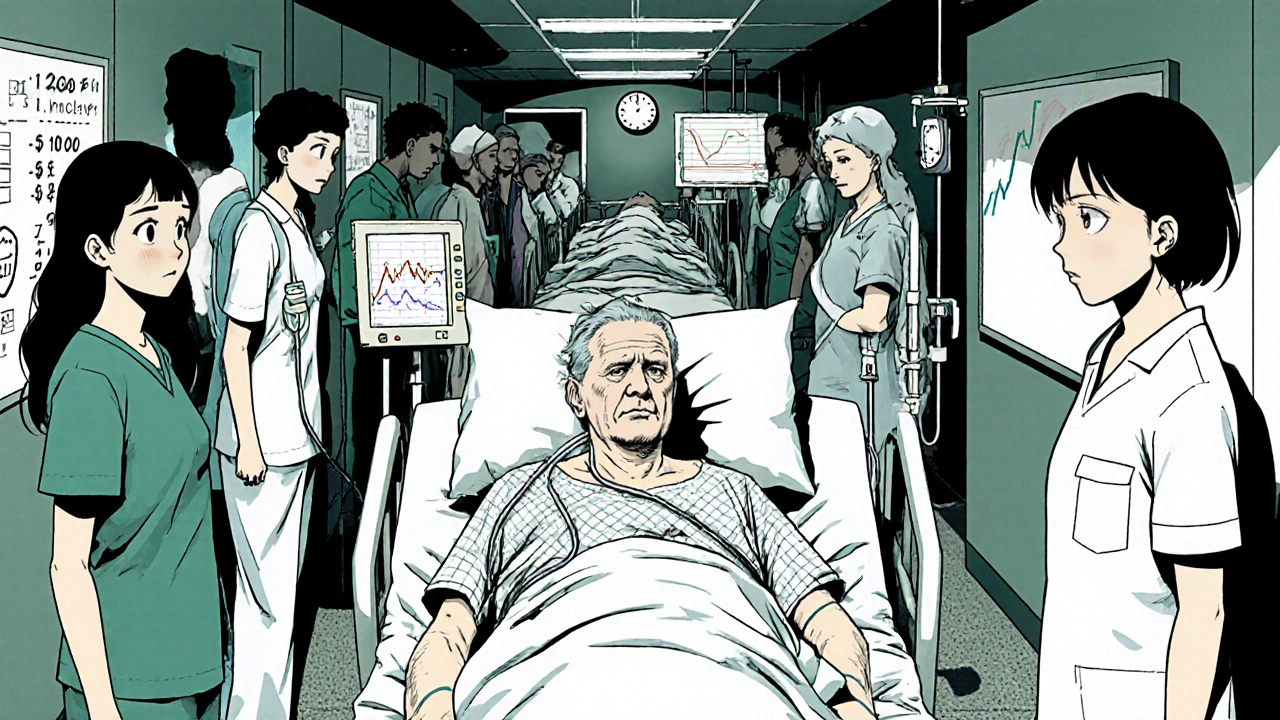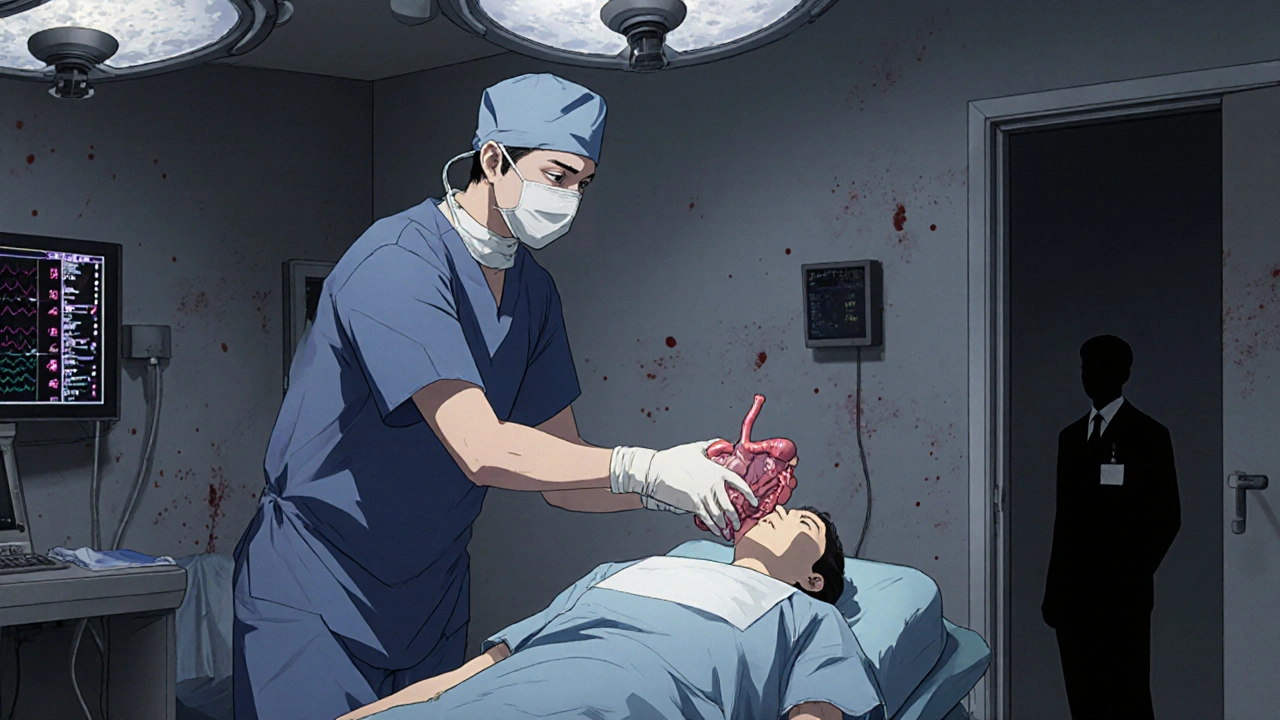Transplant Cost Calculator
Calculate Rejection Costs
Cost Breakdown
Total Estimated Cost:
£0
Potential Savings
With better HLA matching (20% reduction), you could save £0 per patient.
Every year, the failure of a transplanted organ adds a hidden burden to hospitals, insurers, and national health systems. When a graft is lost to organ rejection, the domino effect ripples through operating rooms, intensive‑care units, and even the country’s fiscal plans. This article breaks down exactly how that medical setback translates into real‑world dollars, staffing challenges, and policy headaches.
Quick Takeaways
- Acute rejection episodes cost the NHS roughly £12,000 per patient, while chronic rejection can exceed £45,000.
- Readmission rates after rejection rise to 38 % within 30 days, consuming valuable ICU beds.
- Immunosuppressive drug regimens account for ~30 % of total transplant‑related spending.
- Better HLA matching can cut rejection‑related expenses by up to 20 %.
- Policy‑level investments in tolerance‑inducing therapies promise long‑term savings.
What Is Organ Rejection?
Organ rejection is the immune system’s response that attacks a transplanted organ, leading to loss of function and, often, the need for additional treatment or a second transplant. The body recognises the donor tissue as foreign and launches a cascade of immune cells to destroy it.
Types of Rejection and Their Clinical Footprint
- Hyperacute rejection: Occurs minutes to hours after surgery, usually fatal without immediate graft removal.
- Acute cellular or antibody‑mediated rejection: Peaks within weeks to months; treatable with steroids or plasmapheresis but frequently leads to readmission.
- Chronic rejection: Develops over years, causing progressive organ dysfunction and often culminating in graft loss.
Direct Medical Costs of Rejection
When a graft fails, the following line items spike:
- Hospital readmission: Average stay of 7 days in a high‑dependency unit adds £8,200 per episode.
- Dialysis (for kidney rejection): Three weekly sessions cost £250 each, quickly reaching £13,000 annually.
- Immunosuppressive therapy escalation: Switching from standard tacrolimus to newer agents can increase drug spend by 40 %.
- Surgical re‑transplantation: A second organ transplant can double the initial procedural cost, adding £50,000‑£70,000 depending on the organ.

Indirect and Societal Costs
Beyond the hospital bill, rejection drags down productivity and quality of life:
- Patients miss an average of 18 workdays per rejection episode, costing the UK economy roughly £4,200 per individual.
- Long‑term dependence on dialysis or intensive care raises caregiver burden, estimated at £1.2 billion annually for kidney patients alone.
Impact on Healthcare Resources
Rejection episodes tie up scarce resources that could serve other patients:
- ICU beds: Each acute rejection admission occupies a high‑dependency bed for about a week, shrinking capacity for trauma or cardiac emergencies.
- Specialist staff: Surgeons, transplant coordinators, and immunologists must be re‑deployed, increasing overtime costs and burnout risk.
- Organ allocation: A failed graft means the original donor organ is removed from the waiting list, extending wait times for other candidates.
Funding Challenges for National Health Systems
In the United Kingdom, the National Health Service (NHS) provides publicly funded transplant services and bears the majority of rejection‑related expenses. Budgets are strained by:
- Rising drug prices for newer immunosuppressants.
- Increasing prevalence of obesity and diabetes, which raise the baseline risk of rejection.
- Limited reimbursement models for post‑rejection rehabilitation.

Comparison: Successful Transplant vs. Rejection Scenario
| Metric | Successful transplant (first year) | Rejection episode (first year) |
|---|---|---|
| Procedure cost | £45,000 | £45,000 + £50,000 (re‑transplant) = £95,000 |
| Hospital stay (days) | 12 | 12 + 7 (readmission) = 19 |
| Immunosuppressive drugs (annual) | £8,000 | £12,000 (escalated therapy) |
| Dialysis (if kidney) | £0 | £13,000 |
| Total direct cost | ~£53,000 | ~£130,000 |
Strategies to Reduce the Economic Burden
- Improved HLA matching algorithms: Reduces acute rejection by up to 15 %.
- Tolerance‑inducing protocols: Experimental regimens aim to wean patients off lifelong drugs, cutting medication spend.
- Early biomarker monitoring: Detecting subclinical rejection allows pre‑emptive therapy, avoiding costly re‑operations.
- Bundled payment models: Incentivise hospitals to keep graft survival high, aligning financial risk with outcomes.
Policy Implications and Future Outlook
Policymakers must balance the upfront investment in better matching and novel therapies against the downstream savings from fewer rejection events. The UK’s recent £20 million grant for tolerance research reflects a shift toward long‑term fiscal prudence.
By 2030, experts predict that advances in gene‑editing and machine‑learning‑driven donor‑recipient pairing could halve the current rejection‑related expenditure, freeing billions for other NHS priorities.
Key Takeaway
When a transplant fails, the ripple effect hits patients, clinicians, and the national purse. Understanding the cost anatomy of organ rejection empowers clinicians to choose better matches, encourages researchers to innovate tolerance, and equips decision‑makers to allocate funds where they’ll save the most lives and pounds.
How much does an acute rejection episode cost the NHS?
On average, an acute rejection episode adds about £12,000 to a patient’s care budget, driven by extra hospital days, intensified immunosuppression, and specialist consultations.
Can better HLA matching really lower costs?
Yes. Studies from the UK Transplant Registry show that closely matched donor‑recipient pairs experience 15-20 % fewer acute rejections, translating into millions saved annually in hospital and drug expenses.
What are the indirect societal costs of organ rejection?
Beyond medical bills, rejected grafts lead to lost workdays, increased caregiver strain, and reduced quality‑of‑life scores. The UK economy loses roughly £4,200 per patient in productivity, while families face additional emotional and financial stress.
Are tolerance‑inducing therapies available today?
They are still largely experimental, but early‑phase trials in Europe show promise. If successful, these protocols could eliminate the need for lifelong immunosuppression, dramatically cutting drug costs and infection risk.
How does organ rejection affect ICU capacity?
Each acute rejection admission occupies a high‑dependency or ICU bed for about a week. In a typical UK tertiary centre, this can represent up to 8 % of weekly ICU occupancy, limiting space for other critical cases.



Shan Reddy
October 23, 2025 AT 14:39Organ rejection really drives up the cost of care, especially when patients need a second transplant or extended ICU stays. The extra £12,000 per acute episode adds up quickly across the system. It also pressures staffing because specialists have to juggle emergency cases and follow‑up care. In the long run, better matching could ease a lot of that financial strain.
Michaela Dixon
October 27, 2025 AT 10:39Reading through the figures I’m struck by how the hidden costs weave themselves into every corner of the healthcare tapestry. The acute rejection episodes alone siphon off millions in drug expenditures and bed occupancy. When a graft fails the ripple effect reaches the operating theatre the next week and the pharmacy the following month. It’s a domino effect that can stretch from the surgeon’s clipboard to the patient’s paycheck. The chronic rejection numbers, soaring past £45,000, tell a story of long‑term resource drain that many policymakers overlook. Imagine a transplant centre where each failed kidney propels a cascade of dialysis sessions that add up to an extra £13,000 per patient annually. Those figures melt into the broader economic picture when you factor in lost workdays and caregiver strain. A single ICU bed held for a week by a rejection case could have saved a trauma victim elsewhere. The article’s breakdown of drug costs, especially the 30 % share of total spend, underscores the urgency of smarter immunosuppression strategies. If we could tame the immune response with tolerance‑inducing protocols we might slash the lifelong medication burden dramatically. The data also hint that improved HLA matching could shave off up to 20 % of rejection costs, a win for both patients and the NHS budget. Even modest investments in early biomarker monitoring could catch subclinical rejection before it becomes a costly surgical redo. From a policy perspective, bundling payments to reward graft survival seems like a logical lever to pull. It aligns financial risk with clinical outcomes and could incentivize hospitals to prioritize matching algorithms. The projected halving of rejection‑related expenditure by 2030 feels ambitious yet plausible given the rapid advances in gene editing. All of this paints a picture where clinical vigilance, technological innovation, and fiscal policy converge to ease the hidden burden that organ rejection imposes on society.
Dan Danuts
October 31, 2025 AT 06:39The numbers are eye‑opening.
James Gray
November 4, 2025 AT 02:39Totally get where you’re coming from it’s crazy how a single graft fail can flip the whole budget upside down. I’ve seen hosp teams scramble for beds when a rejection pops up and it’s a mess for everyone.
keerthi yeligay
November 7, 2025 AT 22:39yes the cost ramifies far beyond med bills it ripples into work loss and fam stress. THe data really drives that point home.
Peter Richmond
November 11, 2025 AT 18:39Indeed the staffing challenges you mention merit further analysis. Allocating specialist time to rejection cases inevitably reduces capacity for other critical procedures.